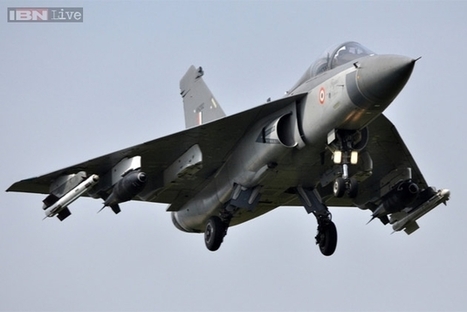
|
Scooped by Patrick H. |
FULL OFFICIAL STATEMENT: It was a defining moment when LCA (Navy) Prototype 1 (NP1), the first indigenously designed and developed 4th plus generation combat aircraft designed to operate from the decks of air-craft carriers, took-off majestically from Ski-Jump facility of Shore Based Test Facility at INS Hansa in Goa at about 12:34 PM today the 20th December 2014.
Piloted by Commodore Jaideep Maolankar, the Chief Test Pilot of National Flight Test Centre, the aircraft had a perfect flight with results matching the predicted ones to the letter. The launch was orchestrated by the Test Director Cdr J D Raturi and Safety Pilot Capt Shivnath Dahiya supported by Gp Capt Anoop Kabadwal, Gp Capt RR Tyagi and Lt Cdr Vivek Pandey. The readiness and availability of aircraft for the event was made possible through the relentless effort of HAL, ARDC under the aegis of Mr P S Roy the Executive Director.
Dr Avinash Chander, SA to RM, Secretary DDR&D DG DRDO congratulated the LCA Navy program team and said, "With today's copybook flight of LCA-Navy from the land based ski-jump facility we see our own indigenous combat aircrafts soon flying from the decks of our aircraft carriers.” Congratulating the team Dr Tamilmani, DS & DG Aeronautics, said “A complex task of Ski Jump of NP1 Executed beautifully”.
LCA (Navy) is designed with stronger landing gears to absorb forces exerted by the ski jump ramp during take-off, to be airborne within 200 m as against 1000m required for normal runways. It’s special flight control law mode allows hands-free take-off relieving the pilot workload, as the aircraft leaps from the ramp and automatically puts the aircraft in an ascending trajectory. The maiden successful, picture perfect launch of NP1 from ski jump at Shore Based Test Facility at Goa is a testimony to the tremendous efforts put in by scientists and engineers to design the Naval aircraft, its simulator (that helps pilots to know well in advance how the aircraft will behave on ski jump) and the flight test team that timed the whole event to near perfection. It can be stated with conviction “The indigenous Indian Naval Carrier Borne Aviation program has been launched, literally from the Ski-Jump".
The LCA Navy program team of ADA (Aeronautical Development Agency) is jubilant on achieving the remarkable feat that is the culmination of several years of design, flight test, simulation and management effort with significant contributions from a number of DRDO laboratories. The teams were ably supported by the certification agency, CEMILAC and the quality assurance agency, CRI (LCA). INS Hansa, the Naval Air Station played the perfect host to achieve this significant milestone. The design teams guided by Program Director ADA Shri P S Subramanyam have ensured that all systems meet the stringent requirements of Carrier borne aircraft. Cmde C D Balaji (Retd) as Project Director LCA (Navy) and it’s Chief Designer has been at the helm of affairs right from the concept phase. The team led by Dr Amitabh Saraf indigenously achieved the flight control laws that take care of the problems encountered by a fly by wire aircraft undertaking a Ski Jump Launch.
The Shore Based Test Facility (SBTF) has been created to replicate the aircraft carrier with a Ski Jump for take-off and arresting gear cable for arrested landing; by ADA with the participation of the Indian Navy, Goa shipyard, CCE (R&D) West, Pune, R&D Engg (E) Pune and the Russian agencies providing the design support and specialized equipment.
No comment yet.
Sign up to comment



 Your new post is loading...
Your new post is loading...







